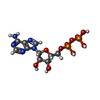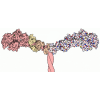[English] 日本語
 Yorodumi
Yorodumi- PDB-7utl: ALTERNATIVE MODELING OF TROPOMYOSIN IN HUMAN CARDIAC THIN FILAMEN... -
+ Open data
Open data
- Basic information
Basic information
| Entry | Database: PDB / ID: 7utl | ||||||
|---|---|---|---|---|---|---|---|
| Title | ALTERNATIVE MODELING OF TROPOMYOSIN IN HUMAN CARDIAC THIN FILAMENT IN THE CALCIUM FREE STATE | ||||||
 Components Components |
| ||||||
 Keywords Keywords | CONTRACTILE PROTEIN / TROPONIN / TROPOMYOSIN / ACTIN / THIN FILEMENT / MUSCLE / CONTRACTILE | ||||||
| Function / homology |  Function and homology information Function and homology informationpositive regulation of heart rate by epinephrine / muscle thin filament tropomyosin / regulation of systemic arterial blood pressure by ischemic conditions / troponin C binding / diaphragm contraction / regulation of ATP-dependent activity / regulation of muscle filament sliding speed / troponin T binding / cardiac myofibril / cardiac Troponin complex ...positive regulation of heart rate by epinephrine / muscle thin filament tropomyosin / regulation of systemic arterial blood pressure by ischemic conditions / troponin C binding / diaphragm contraction / regulation of ATP-dependent activity / regulation of muscle filament sliding speed / troponin T binding / cardiac myofibril / cardiac Troponin complex / bleb / troponin complex / regulation of muscle contraction / regulation of smooth muscle contraction / negative regulation of ATP-dependent activity / transition between fast and slow fiber / positive regulation of ATP-dependent activity / ruffle organization / Striated Muscle Contraction / muscle filament sliding / response to metal ion / regulation of cardiac muscle contraction by calcium ion signaling / structural constituent of muscle / sarcomere organization / cytoskeletal motor activator activity / myosin heavy chain binding / ventricular cardiac muscle tissue morphogenesis / heart contraction / tropomyosin binding / regulation of heart contraction / negative regulation of vascular associated smooth muscle cell migration / actin filament bundle / troponin I binding / filamentous actin / mesenchyme migration / actin filament bundle assembly / negative regulation of vascular associated smooth muscle cell proliferation / skeletal muscle myofibril / striated muscle thin filament / skeletal muscle thin filament assembly / actin monomer binding / Smooth Muscle Contraction / skeletal muscle contraction / vasculogenesis / calcium channel inhibitor activity / cytoskeletal protein binding / skeletal muscle fiber development / cardiac muscle contraction / stress fiber / positive regulation of stress fiber assembly / Ion homeostasis / titin binding / actin filament polymerization / cytoskeleton organization / positive regulation of cell adhesion / negative regulation of cell migration / actin filament organization / sarcomere / cellular response to reactive oxygen species / actin filament / filopodium / wound healing / response to calcium ion / structural constituent of cytoskeleton / Hydrolases; Acting on acid anhydrides; Acting on acid anhydrides to facilitate cellular and subcellular movement / ruffle membrane / intracellular calcium ion homeostasis / calcium-dependent protein binding / actin filament binding / regulation of cell shape / lamellipodium / actin cytoskeleton / heart development / cell body / actin binding / cytoskeleton / hydrolase activity / protein heterodimerization activity / protein domain specific binding / calcium ion binding / positive regulation of gene expression / protein kinase binding / magnesium ion binding / protein homodimerization activity / ATP binding / identical protein binding / cytoplasm / cytosol Similarity search - Function | ||||||
| Biological species |  Homo sapiens (human) Homo sapiens (human) | ||||||
| Method | ELECTRON MICROSCOPY / single particle reconstruction / cryo EM / Resolution: 6.6 Å | ||||||
 Authors Authors | Rynkiewicz, M.J. / Pavadai, E. / Lehman, W. | ||||||
| Funding support |  United States, 1items United States, 1items
| ||||||
 Citation Citation |  Journal: Biophys J / Year: 2020 Journal: Biophys J / Year: 2020Title: Protein-Protein Docking Reveals Dynamic Interactions of Tropomyosin on Actin Filaments. Authors: Elumalai Pavadai / William Lehman / Michael J Rynkiewicz /  Abstract: Experimental approaches such as fiber diffraction and cryo-electron microscopy reconstruction have defined regulatory positions of tropomyosin on actin but have not, as yet, succeeded at determining ...Experimental approaches such as fiber diffraction and cryo-electron microscopy reconstruction have defined regulatory positions of tropomyosin on actin but have not, as yet, succeeded at determining key atomic-level contacts between these proteins or fully substantiated the dynamics of their interactions at a structural level. To overcome this deficiency, we have previously employed computational approaches to deduce global dynamics of thin filament components by energy landscape determination and molecular dynamics simulations. Still, these approaches remain computationally challenging for any complex and large macromolecular assembly like the thin filament. For example, tropomyosin cable wrapping around actin of thin filaments features both head-to-tail polymeric interactions and local twisting, both of which depart from strict superhelical symmetry. This produces a complex energy surface that is difficult to model and thus to evaluate globally. Therefore, at this stage of our understanding, assessing global molecular dynamics can prove to be inherently impractical. As an alternative, we adopted a "divide and conquer" protocol to investigate actin-tropomyosin interactions at an atomistic level. Here, we first employed unbiased protein-protein docking tools to identify binding specificity of individual tropomyosin pseudorepeat segments over the actin surface. Accordingly, tropomyosin "ligand" segments were rotated and translated over potential "target" binding sites on F-actin where the corresponding interaction energetics of billions of conformational poses were ranked by the programs PIPER and ClusPro. These data were used to assess favorable interactions and then to rebuild models of seamless and continuous tropomyosin cables over the F-actin substrate, which were optimized further by flexible fitting routines and molecular dynamics. The models generated azimuthally distinct regulatory positions for tropomyosin cables along thin filaments on actin dominated by stereo-specific head-to-tail overlap linkage. The outcomes are in good agreement with current cryo-electron microscopy topology and consistent with long-thought residue-to-residue interactions between actin and tropomyosin. #1:  Journal: Nat Commun / Year: 2020 Journal: Nat Commun / Year: 2020Title: Cardiac muscle thin filament structures reveal calcium regulatory mechanism. Authors: Yurika Yamada / Keiichi Namba / Takashi Fujii /  Abstract: Contraction of striated muscles is driven by cyclic interactions of myosin head projecting from the thick filament with actin filament and is regulated by Ca released from sarcoplasmic reticulum. ...Contraction of striated muscles is driven by cyclic interactions of myosin head projecting from the thick filament with actin filament and is regulated by Ca released from sarcoplasmic reticulum. Muscle thin filament consists of actin, tropomyosin and troponin, and Ca binding to troponin triggers conformational changes of troponin and tropomyosin to allow actin-myosin interactions. However, the structural changes involved in this regulatory mechanism remain unknown. Here we report the structures of human cardiac muscle thin filament in the absence and presence of Ca by electron cryomicroscopy. Molecular models in the two states built based on available crystal structures reveal the structures of a C-terminal region of troponin I and an N-terminal region of troponin T in complex with the head-to-tail junction of tropomyosin together with the troponin core on actin filament. Structural changes of the thin filament upon Ca binding now reveal the mechanism of Ca regulation of muscle contraction. #2:  Journal: Biochem Biophys Res Commun / Year: 2021 Journal: Biochem Biophys Res Commun / Year: 2021Title: C-terminal troponin-I residues trap tropomyosin in the muscle thin filament blocked-state. Authors: Lehman, W. / Pavadai, E. / Rynkiewicz, M.J. | ||||||
| History |
|
- Structure visualization
Structure visualization
| Structure viewer | Molecule:  Molmil Molmil Jmol/JSmol Jmol/JSmol |
|---|
- Downloads & links
Downloads & links
- Download
Download
| PDBx/mmCIF format |  7utl.cif.gz 7utl.cif.gz | 2.8 MB | Display |  PDBx/mmCIF format PDBx/mmCIF format |
|---|---|---|---|---|
| PDB format |  pdb7utl.ent.gz pdb7utl.ent.gz | Display |  PDB format PDB format | |
| PDBx/mmJSON format |  7utl.json.gz 7utl.json.gz | Tree view |  PDBx/mmJSON format PDBx/mmJSON format | |
| Others |  Other downloads Other downloads |
-Validation report
| Summary document |  7utl_validation.pdf.gz 7utl_validation.pdf.gz | 1.7 MB | Display |  wwPDB validaton report wwPDB validaton report |
|---|---|---|---|---|
| Full document |  7utl_full_validation.pdf.gz 7utl_full_validation.pdf.gz | 1.8 MB | Display | |
| Data in XML |  7utl_validation.xml.gz 7utl_validation.xml.gz | 197.9 KB | Display | |
| Data in CIF |  7utl_validation.cif.gz 7utl_validation.cif.gz | 311.5 KB | Display | |
| Arichive directory |  https://data.pdbj.org/pub/pdb/validation_reports/ut/7utl https://data.pdbj.org/pub/pdb/validation_reports/ut/7utl ftp://data.pdbj.org/pub/pdb/validation_reports/ut/7utl ftp://data.pdbj.org/pub/pdb/validation_reports/ut/7utl | HTTPS FTP |
-Related structure data
| Related structure data |  0728M  7utiC M: map data used to model this data C: citing same article ( |
|---|---|
| Similar structure data | Similarity search - Function & homology  F&H Search F&H Search |
- Links
Links
- Assembly
Assembly
| Deposited unit | 
|
|---|---|
| 1 |
|
- Components
Components
-Protein , 5 types, 34 molecules ABCDEFGHIJKLMNOPQRabWZijghXYef...
| #1: Protein | Mass: 42109.973 Da / Num. of mol.: 18 / Source method: isolated from a natural source / Source: (natural)  #2: Protein | Mass: 32763.621 Da / Num. of mol.: 8 Source method: isolated from a genetically manipulated source Source: (gene. exp.)  Homo sapiens (human) / Gene: TPM1, C15orf13, TMSA / Production host: Homo sapiens (human) / Gene: TPM1, C15orf13, TMSA / Production host:  #3: Protein | Mass: 34659.387 Da / Num. of mol.: 4 Source method: isolated from a genetically manipulated source Source: (gene. exp.)  Homo sapiens (human) / Gene: TNNT2 / Production host: Homo sapiens (human) / Gene: TNNT2 / Production host:  #4: Protein | Mass: 24058.686 Da / Num. of mol.: 2 Source method: isolated from a genetically manipulated source Source: (gene. exp.)  Homo sapiens (human) / Gene: TNNI3, TNNC1 / Production host: Homo sapiens (human) / Gene: TNNI3, TNNC1 / Production host:  #5: Protein | Mass: 18419.482 Da / Num. of mol.: 2 Source method: isolated from a genetically manipulated source Source: (gene. exp.)  Homo sapiens (human) / Gene: TNNC1, TNNC / Production host: Homo sapiens (human) / Gene: TNNC1, TNNC / Production host:  |
|---|
-Non-polymers , 2 types, 36 molecules 


| #6: Chemical | ChemComp-ADP / #7: Chemical | ChemComp-MG / |
|---|
-Details
| Has ligand of interest | N |
|---|
-Experimental details
-Experiment
| Experiment | Method: ELECTRON MICROSCOPY |
|---|---|
| EM experiment | Aggregation state: FILAMENT / 3D reconstruction method: single particle reconstruction |
- Sample preparation
Sample preparation
| Component | Name: HUMAN CARDIAC THIN FILAMENT IN THE CALCIUM FREE STATE / Type: COMPLEX / Entity ID: #1-#5 / Source: MULTIPLE SOURCES |
|---|---|
| Buffer solution | pH: 7.5 |
| Specimen | Conc.: 0.05 mg/ml / Embedding applied: NO / Shadowing applied: NO / Staining applied: NO / Vitrification applied: YES |
| Specimen support | Grid material: MOLYBDENUM / Grid type: Quantifoil R1.2/1.3 |
| Vitrification | Instrument: LEICA EM GP / Cryogen name: ETHANE / Humidity: 80 % |
- Electron microscopy imaging
Electron microscopy imaging
| Microscopy | Model: JEOL CRYO ARM 200 |
|---|---|
| Electron gun | Electron source:  FIELD EMISSION GUN / Accelerating voltage: 200 kV / Illumination mode: FLOOD BEAM FIELD EMISSION GUN / Accelerating voltage: 200 kV / Illumination mode: FLOOD BEAM |
| Electron lens | Mode: BRIGHT FIELD / Nominal defocus max: 1800 nm / Nominal defocus min: 700 nm |
| Image recording | Electron dose: 65 e/Å2 / Film or detector model: GATAN K2 SUMMIT (4k x 4k) |
- Processing
Processing
| CTF correction | Type: PHASE FLIPPING AND AMPLITUDE CORRECTION |
|---|---|
| 3D reconstruction | Resolution: 6.6 Å / Resolution method: FSC 0.143 CUT-OFF / Num. of particles: 21588 / Symmetry type: POINT |
 Movie
Movie Controller
Controller



 PDBj
PDBj








